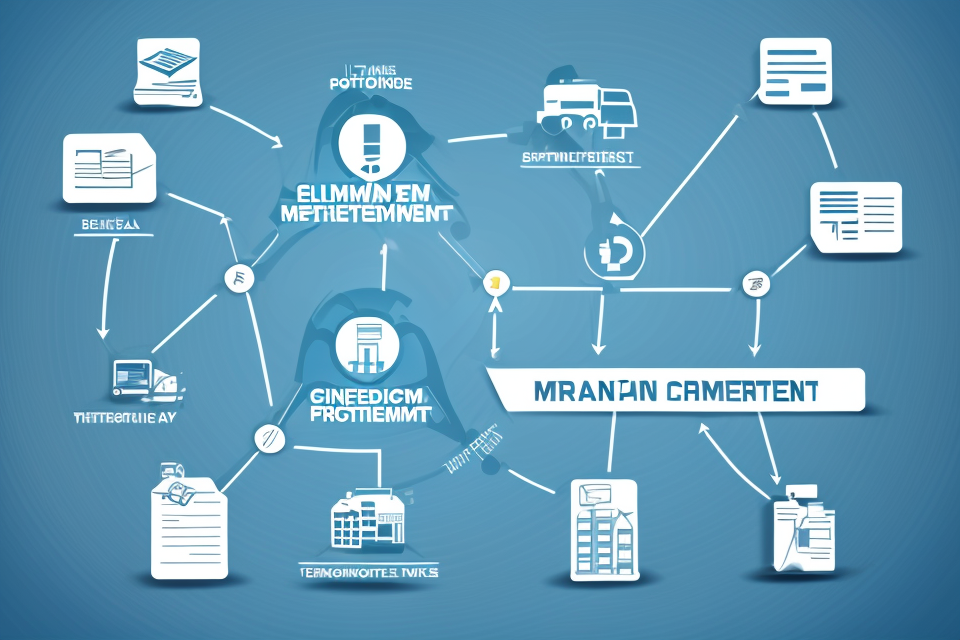Supply chain management (SCM) is the coordination and management of activities involved in the production and delivery of a product or service. It encompasses all stages of the supply chain, from sourcing raw materials to delivering the final product to the customer. But who defines supply chain management? Is it a single entity or a collective effort? In this comprehensive guide, we will explore the concept of supply chain management and the various stakeholders involved in defining it. From suppliers to manufacturers, distributors to retailers, and logistics providers to customers, each player has a role to play in shaping the supply chain. Understanding the concept of supply chain management is crucial for businesses to remain competitive and meet customer demands. So, let’s dive in and explore the intricacies of supply chain management.
What is Supply Chain Management?
Definition and Importance
Supply Chain Management (SCM) is the coordination and management of activities involved in the production and delivery of a product or service. It encompasses the entire process, from sourcing raw materials to delivering the final product to the customer.
SCM is crucial in today’s business landscape for several reasons:
- Efficiency and cost savings: Effective SCM can help companies optimize their operations, reduce waste, and lower costs. By streamlining processes and improving efficiency, companies can improve their bottom line and remain competitive.
- Customer satisfaction: A well-managed supply chain can ensure that products are delivered on time and in good condition, leading to higher customer satisfaction. By understanding customer needs and expectations, companies can tailor their supply chain to meet those needs and enhance the customer experience.
- Innovation and adaptability: A flexible and responsive supply chain can enable companies to quickly adapt to changing market conditions and customer demands. This can help companies stay ahead of the competition and maintain a competitive edge.
- Risk management: A robust supply chain can help companies mitigate risks associated with disruptions in the supply chain, such as natural disasters, geopolitical events, and other unforeseen circumstances. By having contingency plans in place and maintaining good relationships with suppliers and partners, companies can minimize the impact of these risks on their operations.
Overall, supply chain management is a critical component of any business’s success. By understanding the definition and importance of SCM, companies can better manage their operations and improve their overall performance.
Key Components of Supply Chain Management
Supply Chain Management (SCM) is a comprehensive approach to managing the flow of goods and services from the supplier to the customer. The key components of SCM are procurement, logistics, production, distribution, and inventory management.
- Procurement: Procurement is the process of acquiring goods and services from suppliers. It involves identifying the required materials and services, negotiating contracts, and managing relationships with suppliers. The objective of procurement is to ensure that the right goods and services are delivered at the right time and at the right price.
- Logistics: Logistics refers to the management of the physical movement of goods and services. It includes transportation, warehousing, and inventory management. The goal of logistics is to ensure that goods and services are delivered to the right place at the right time in the right condition.
- Production: Production is the process of converting raw materials into finished goods. It involves planning, scheduling, and controlling the production process. The objective of production is to optimize efficiency and reduce costs while maintaining quality.
- Distribution: Distribution refers to the delivery of goods and services to customers. It includes order processing, shipping, and customer service. The goal of distribution is to ensure that customers receive their orders on time and in good condition.
- Inventory Management: Inventory management is the process of managing the inventory levels of goods and services. It involves forecasting demand, managing stock levels, and monitoring inventory movement. The objective of inventory management is to ensure that the right goods and services are available at the right time while minimizing inventory costs.
Overall, the key components of SCM are interdependent and work together to ensure that goods and services are delivered efficiently and effectively to customers. By optimizing each component, businesses can improve their competitiveness and profitability.
The History of Supply Chain Management
Evolution of the Concept
- Early beginnings
- The origins of supply chain management can be traced back to the ancient civilizations such as the Egyptians, Greeks, and Romans, who developed complex systems for the storage and transportation of goods.
- In these societies, supply chain management was mainly focused on the procurement and distribution of food and other essential items.
- Key milestones in the development of SCM
- The Industrial Revolution marked a significant turning point in the evolution of supply chain management.
- The mass production of goods required the development of efficient methods for the distribution and delivery of products to customers.
- The advent of the automobile and the growth of the interstate highway system in the 20th century led to the development of modern supply chain management practices.
- The increased mobility of goods and the rise of just-in-time delivery systems required the coordination of multiple stages of the supply chain, including procurement, production, and distribution.
- The advent of the internet and the growth of e-commerce in the late 20th and early 21st centuries has further transformed the landscape of supply chain management.
- The proliferation of online retail and the rise of omnichannel shopping have created new challenges and opportunities for supply chain managers, who must now coordinate with a wide range of stakeholders, including suppliers, manufacturers, distributors, and logistics providers.
- The Industrial Revolution marked a significant turning point in the evolution of supply chain management.
Contemporary Challenges and Trends
Globalization
Globalization has been a significant driver of change in the supply chain management landscape. As companies expand their operations across borders, they must navigate complex regulatory environments, fluctuating currency values, and diverse cultural practices. This requires supply chain managers to adopt a global perspective and develop strategies that can effectively manage risks and capitalize on opportunities in different markets.
Technological advancements
Technological advancements have also played a critical role in shaping the contemporary supply chain management landscape. The advent of the internet, cloud computing, and big data analytics has enabled companies to gather and analyze vast amounts of information in real-time. This has enabled supply chain managers to optimize their operations by improving forecasting, inventory management, and transportation planning.
Sustainability and ethical considerations
Sustainability and ethical considerations have become increasingly important in the supply chain management field. Companies are under pressure to reduce their environmental footprint and ensure that their supply chains are free from labor abuses and human rights violations. This has led to the development of new standards and certifications, such as ISO 26000 and SA8000, which aim to promote sustainable and ethical practices in the supply chain. Supply chain managers must navigate these complex issues while balancing the competing demands of cost, quality, and speed.
The Players in Supply Chain Management
Stakeholders and Their Roles
In a supply chain, there are various stakeholders who play a crucial role in ensuring the smooth flow of goods and services from the supplier to the end consumer. Understanding the roles of these stakeholders is essential for effective supply chain management. The following are the main stakeholders in a supply chain:
Suppliers
Suppliers are the entities that provide the raw materials, components, or finished goods required by the manufacturers. They play a critical role in the supply chain as they are responsible for ensuring that the products they supply meet the required quality standards and are delivered on time.
Manufacturers
Manufacturers are the entities that convert the raw materials and components supplied by the suppliers into finished goods. They are responsible for ensuring that the finished goods meet the required quality standards and are delivered to the customers on time.
Distributors
Distributors are the entities that facilitate the movement of goods from the manufacturers to the retailers. They play a crucial role in ensuring that the goods are delivered to the retailers on time and in good condition.
Retailers
Retailers are the entities that sell the finished goods to the end consumers. They play a crucial role in ensuring that the products are marketed and sold effectively to the consumers.
Consumers
Consumers are the end-users of the products. They play a crucial role in the supply chain as they provide feedback on the products and their needs and preferences. This feedback helps the manufacturers and retailers to improve their products and services.
Overall, each stakeholder in the supply chain has a critical role to play in ensuring the smooth flow of goods and services from the supplier to the end consumer. Understanding the roles of these stakeholders is essential for effective supply chain management.
Collaboration and Partnerships
Collaboration and partnerships are crucial elements in supply chain management as they allow companies to share resources, expertise, and risks. This can lead to improved efficiency, reduced costs, and increased customer satisfaction. In this section, we will discuss the importance of strong relationships in supply chain management and provide case studies of successful partnerships.
Importance of Strong Relationships
Building strong relationships with suppliers, customers, and other partners is essential for success in supply chain management. These relationships are built on trust, open communication, and mutual understanding of each party’s needs and goals. By fostering strong relationships, companies can ensure that their partners are committed to the same level of quality, service, and reliability.
Case Studies of Successful Partnerships
There are many examples of successful partnerships in supply chain management. One example is the partnership between Procter & Gamble and Walmart. In this partnership, Procter & Gamble provides Walmart with real-time data on the availability of its products, allowing Walmart to better manage its inventory and improve customer satisfaction. This partnership has resulted in increased sales and improved efficiency for both companies.
Another example is the partnership between Dell and Intel. In this partnership, Dell uses Intel’s technology to improve the performance and reliability of its computers. This partnership has allowed Dell to offer customers a higher-quality product and has helped both companies to grow their businesses.
Overall, collaboration and partnerships are critical components of successful supply chain management. By working together with suppliers, customers, and other partners, companies can achieve greater efficiency, reduce costs, and improve customer satisfaction.
Best Practices in Supply Chain Management
Strategic Planning
Forecasting Demand
Accurate demand forecasting is crucial for supply chain management. It helps in determining the demand for products and services, which in turn helps in planning inventory levels, production schedules, and resource allocation. Forecasting demand involves analyzing historical sales data, market trends, and customer behavior to predict future demand.
Inventory Optimization
Inventory optimization is another critical aspect of strategic planning in supply chain management. It involves managing inventory levels to meet customer demand while minimizing inventory costs. This can be achieved by implementing just-in-time (JIT) inventory systems, which ensure that products are delivered to customers only when they are needed, reducing inventory holding costs.
Risk Management
Risk management is an essential component of strategic planning in supply chain management. Risks can arise from various sources, such as natural disasters, supplier failures, and changes in market conditions. Risk management involves identifying potential risks, assessing their impact on the supply chain, and developing strategies to mitigate or eliminate them. This can include diversifying suppliers, implementing backup plans, and investing in risk management tools and technologies.
Technology and Innovation
The role of digital tools in supply chain management (SCM) cannot be overstated. From supply chain visibility to demand forecasting, these tools help businesses optimize their operations and improve customer satisfaction. However, as technology continues to evolve, it’s important for companies to stay up-to-date with the latest trends and innovations.
Here are some emerging technologies and their impact on supply chain management:
Artificial Intelligence (AI)
AI has the potential to revolutionize the way businesses manage their supply chains. With the ability to analyze vast amounts of data, AI can help companies identify patterns and make predictions about future demand. This, in turn, can help businesses optimize their inventory levels and reduce waste.
Internet of Things (IoT)
The IoT refers to the network of physical devices that are connected to the internet. In the context of supply chain management, IoT devices can be used to track shipments, monitor warehouse conditions, and even predict equipment failures. This can help businesses reduce costs, improve efficiency, and minimize downtime.
Blockchain
Blockchain technology has the potential to improve transparency and security in supply chain management. By creating a decentralized ledger of all transactions, blockchain can help businesses track the movement of goods and ensure that all parties involved in the supply chain are legitimate. This can help businesses reduce the risk of fraud and improve trust between suppliers and customers.
Robotics
Robotics can help businesses automate repetitive tasks and improve efficiency in the warehouse. From autonomous forklifts to robotic arms that can pick and pack orders, robotics can help businesses reduce labor costs and improve accuracy.
Overall, technology and innovation play a critical role in supply chain management. By staying up-to-date with the latest trends and adopting new technologies, businesses can improve their operations and gain a competitive advantage in the marketplace.
Continuous Improvement
Continuous improvement is a critical component of supply chain management. It involves a continuous process of identifying and implementing changes to improve the efficiency and effectiveness of the supply chain. There are several best practices that organizations can follow to achieve continuous improvement in their supply chain management processes.
- Lean Principles: Lean principles are a set of practices that focus on minimizing waste and maximizing efficiency in the supply chain. This includes practices such as just-in-time (JIT) inventory management, continuous flow production, and continuous process improvement. By adopting lean principles, organizations can reduce inventory costs, improve delivery times, and increase productivity.
- Six Sigma Methodologies: Six Sigma is a data-driven approach to process improvement that aims to reduce defects and improve efficiency. It involves using statistical analysis to identify areas of the supply chain that require improvement and implementing changes to achieve significant reductions in defects and improvements in efficiency. Six Sigma methodologies can help organizations reduce costs, improve quality, and increase customer satisfaction.
- Benchmarking and Performance Measurement: Benchmarking is the process of comparing an organization’s supply chain performance against industry best practices. This can help organizations identify areas where they can improve their processes and adopt best practices from other organizations. Performance measurement is also critical to continuous improvement in supply chain management. By measuring key performance indicators (KPIs) such as on-time delivery, inventory turnover, and lead time, organizations can identify areas where they need to improve and track their progress over time.
Overall, continuous improvement is essential for organizations to remain competitive in today’s fast-paced business environment. By adopting best practices such as lean principles, Six Sigma methodologies, and benchmarking and performance measurement, organizations can continuously improve their supply chain management processes and achieve significant cost savings, improvements in quality, and increases in customer satisfaction.
The Future of Supply Chain Management
Emerging Trends and Challenges
The Impact of Industry 4.0
Industry 4.0, also known as the Fourth Industrial Revolution, refers to the integration of advanced technologies such as artificial intelligence, the Internet of Things, and robotics into manufacturing and supply chain processes. This trend has the potential to revolutionize supply chain management by increasing efficiency, reducing costs, and improving decision-making. For example, the use of predictive analytics and machine learning algorithms can help supply chain managers identify patterns and trends in data, allowing them to make more informed decisions about inventory management and resource allocation.
Supply Chain Digitalization
Another key trend in the future of supply chain management is the growing importance of digitalization. As more and more businesses move their operations online, the need for digital supply chain solutions is increasing. This includes the use of e-commerce platforms, digital inventory management systems, and other digital tools to streamline supply chain processes. By digitizing their supply chains, companies can improve visibility, reduce errors, and increase efficiency.
The Role of Artificial Intelligence and Automation
Artificial intelligence (AI) and automation are also playing an increasingly important role in supply chain management. AI algorithms can be used to analyze large amounts of data and identify patterns and trends, while automation can help reduce costs and increase efficiency by automating repetitive tasks. For example, AI-powered robots can be used to perform tasks such as picking and packing, while automated inventory management systems can help ensure that products are always in stock.
However, the use of AI and automation also presents challenges, such as the need for companies to invest in new technologies and the potential for job displacement. As such, it is important for supply chain managers to carefully consider the benefits and risks of these emerging trends when planning for the future.
Opportunities and Adaptation
Emphasis on Sustainability and Environmental Concerns
As global awareness surrounding environmental issues continues to grow, businesses are under increasing pressure to adopt sustainable practices throughout their supply chains. This presents an opportunity for companies to not only reduce their environmental impact but also enhance their reputation and customer loyalty. Key areas of focus include reducing carbon emissions, optimizing resource use, and implementing circular economy principles.
Changing Consumer Preferences and Demands
The consumer landscape is evolving rapidly, with heightened expectations for transparency, ethical sourcing, and personalized experiences. Companies must adapt to these shifting preferences by embracing technology and data-driven decision-making to enhance their supply chain visibility and responsiveness. This includes utilizing advanced analytics, leveraging social media for market insights, and exploring new distribution channels such as e-commerce and direct-to-consumer models.
Strategies for Resilience and Agility in the Face of Uncertainty
In an increasingly volatile world, supply chain managers must develop strategies to mitigate risks and ensure the continuity of their operations. This involves building resilient supply networks through diversification, redundancy, and strategic partnerships. Companies should also invest in advanced technologies, such as artificial intelligence and machine learning, to improve forecasting accuracy and optimize inventory management. Moreover, fostering a culture of innovation and adaptability within the organization is crucial for navigating the challenges and opportunities that lie ahead.
FAQs
1. Who defines supply chain management?
Supply chain management is a term that has been defined by various experts and organizations over the years. Generally, it is defined as the management of the flow of goods and services, including raw materials, intermediate goods, and finished products, from the point of origin to the point of consumption. This involves coordinating and optimizing all activities related to the production, storage, transportation, and distribution of these goods and services.
2. What is the history of supply chain management?
The concept of supply chain management has its roots in the early 20th century, when companies began to focus on efficiency and productivity in their operations. In the 1960s and 1970s, the concept of materials management emerged, which emphasized the importance of managing the flow of materials and inventory in a company’s operations. The term “supply chain management” was first used in the 1980s, and the concept gained popularity in the 1990s with the rise of globalization and the increased focus on customer service and satisfaction.
3. What are the key components of supply chain management?
The key components of supply chain management include procurement, production, inventory management, transportation, and logistics. These components are interdependent and must be carefully coordinated to ensure the efficient and effective flow of goods and services. Other important aspects of supply chain management include information technology, risk management, and sustainability.
4. Why is supply chain management important?
Supply chain management is important because it helps companies to achieve their goals and objectives by ensuring the efficient and effective flow of goods and services. It can help to reduce costs, improve customer service, increase responsiveness to changes in demand, and enhance the competitiveness of a company. In today’s global economy, effective supply chain management is critical for companies to remain competitive and successful.
5. What are some challenges in supply chain management?
Some of the challenges in supply chain management include managing complexity, ensuring visibility and transparency, balancing supply and demand, managing risks and uncertainties, and maintaining sustainability. These challenges can be addressed through the use of advanced technologies, such as artificial intelligence and the Internet of Things, as well as through the development of strong partnerships and collaborations within the supply chain.



